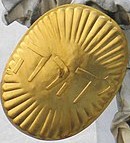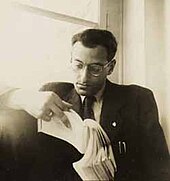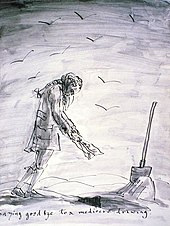Philipp Fehl

Philipp Pinhas Fehl (born May 9, 1920 in Vienna ; died September 11, 2000 in Rome ) was an Austrian-American art historian .
Life
Philipp Fehl was the son of the Jewish shoemaker Hugo Fehl and Friedericke Beck, his younger brother Arnold Fehl (1922–1978) became an engineer and worked for a while with the cousin and inventor of circuit boards Paul Eisler (1907–1992). Another cousin was the Austro-American ballet photographer Fred Fehl (1906–1995).
Fehl attended grammar school in Vienna, he later remembered that his father showed him the golden name of God at the Michaelerkirche and wrote about it in 1997 in its meaning and form . After the annexation of Austria , he fled the persecution of the German Jews to Czechoslovakia and from there to Great Britain. His parents also managed to escape. Fehl worked in a cinema poster printer in Birmingham and learned silk screen printing . In August 1940 he came to the USA and began studying painting at the Art Institute of Chicago . Fehl became a soldier in the US Army in 1942 and was granted citizenship in 1943 . He was used as a military policeman in prisoner-of-war camps for German soldiers. In 1945 he married the emigrant Raina Schweinburg (1920–2009), also from Vienna , daughter of the writer Erich Fritz Schweinburg ; they had two children. Raina Fehl became a teacher of ancient languages. After their discharge from the army, the two volunteered for a military assignment as interrogation officers at the Nuremberg trials .
After returning to the USA, Fehl studied art history from 1948 to 1952 at the University of Chicago, among others with Ulrich Middeldorf and Peter Heinrich von Blanckenhagen . Failed in 1963 at the University of Chicago with a dissertation on statues of Greek and Roman antiquity doctorate . He received teaching positions at several universities and in 1969 became professor of art history at the University of Illinois at Urbana-Champaign , where he retired in 1990. The Fehl couple founded the International Survey of Jewish Monuments, ISJM, in 1977, of which he was president until 1997.
From 1990 he worked with his wife in Rome in the book collection of Leopoldo Cicognara , which is part of the Vatican Library .
Fehl also worked as a painter; At first he drew in the Expressionist style, after 1945 he painted 800 Capricci (ink / paper) based on Giovanni Domenico Tiepolo , which he called “picture poems”.
Fonts (selection)
Exhibitions
- Brita Eckert, Harro Kieser (arrangement): Philipp P. Fehl, Capricci: an exhibition of the German Exile Archive 1933–1945 of the German Library. 2001.
Fonts
- The Classical Monument: Reflections on the Connection between Morality and Art in Greek and Roman Sculpture. New York University Press, New York 1972 (Dissertation Chicago 1963).
- Thomas Appleton of Livorno and Canova's statue of George Washington. In: Antje Kosegarten , Peter Tigler (eds.): Festschrift Ulrich Middeldorf. Berlin: De Gruyter, 1968, pp. 557-560.
-
The Ghosts of Nuremberg , in: The Atlantic Monthly, Boston, March 1972.
- The ghosts of Nuremberg. In: Sense and Form . No. 2, 1999, pp. 275-298. Translation of Freia Hartung.
- Franciscus Junius (the younger), The Literature of Classical Art I. The Painting of the Ancients, London, 1638. II. Catalogus Architectorum, Mechanicorum sed praecipue . A critical edition and translation by Keith Aldrich, Philipp Fehl and Raina Fehl. University of California Press, Berkeley.
- Sprezzatura and the art of painting finely open-ended narration in paintings by Apelles, Raphael, Michelangelo, Titian, Rembrandt and Ter Borch. The Gerson Lectures Foundation, Groningen 1997.
- Nostalgia and art history. The golden name of God on Michaelerplatz in Vienna. In: Sense and Form. Volume 2, 1997, pp. 293-297.
- with Raina Fehl (Ed.): Catalogo ragionao dei libri d'arte e d'antichita posseduti dal Conte Cocognara. 1821. Vatican, 2001.
- with Raina Fehl: The Cicognara Library: Literary Sources in the History of Art and Kindred Subjects. Leopoldo Cicognara Program at the University of Illinois Library in Association with the Vatican Library, Vatican City, 1989–2009. Microfiche collection of around 5,000 titles.
- Raina Fehl, Richard Bösel (eds.), Philipp P. Fehl: Monuments and the art of mourning: the tombs of popes and princes in St. Peter's. Unione internazionale degli istituti di archeologia storia e storia dell'arte, Rome 2007.
literature
- Christine pipe cutter: false, Philip P. . In: General Artist Lexicon . The visual artists of all times and peoples (AKL). Volume 37, Saur, Munich a. a. 2003, ISBN 3-598-22777-9 , p. 482.
- Wrong, Philipp. In: Werner Röder; Herbert A. Strauss (Ed.): International Biographical Dictionary of Central European Emigrés 1933–1945. Volume 2.1. Saur, Munich 1983, ISBN 3-598-10089-2 , p. 283.
- Steffen Radlmaier : The Nuremberg learning process: from war criminals and star reporters. Compiled and introduced by Steffen Radlmaier. Eichborn, Frankfurt am Main 2001, ISBN 978-3-8218-4503-6 , series Die Other Bibliothek . Short biography p. 354.
- Richard Bösel (ed.); Ernst Gombrich , Nikolaus Vielmetti, Hans Aurenhammer (contributions): Philipp P. Fehl - art historian and artist = Philipp P. Fehl - storico dell'arte e artista. Ed. De Luca, Rome 2002 (list of publications pp. 103–117).
- Marilyn Perry: Philipp P. Fehl artist, scholar, humanist, witness. In: Artibus et historiae. Volume 24, No. 48, Krakau 2003, pp. 13-15, ISSN 0391-9064 .
Web links
- Literature by and about Philipp Fehl in the catalog of the German National Library
- Literature by and about Philipp Fehl in the bibliographic database WorldCat
- Philipp Fehl , website
- Philipp Fehl's estate in the German Exile Archive of the German National Library
Individual evidence
- ^ International Survey of Jewish Monuments , website
| personal data | |
|---|---|
| SURNAME | Wrong, Philipp |
| ALTERNATIVE NAMES | Fehl, Philipp Pinhas (full name) |
| BRIEF DESCRIPTION | Austrian-American art historian |
| DATE OF BIRTH | May 9, 1920 |
| PLACE OF BIRTH | Vienna |
| DATE OF DEATH | September 11, 2000 |
| Place of death | Rome |


